2017 PEUGEOT 5008 belt
[x] Cancel search: beltPage 168 of 404
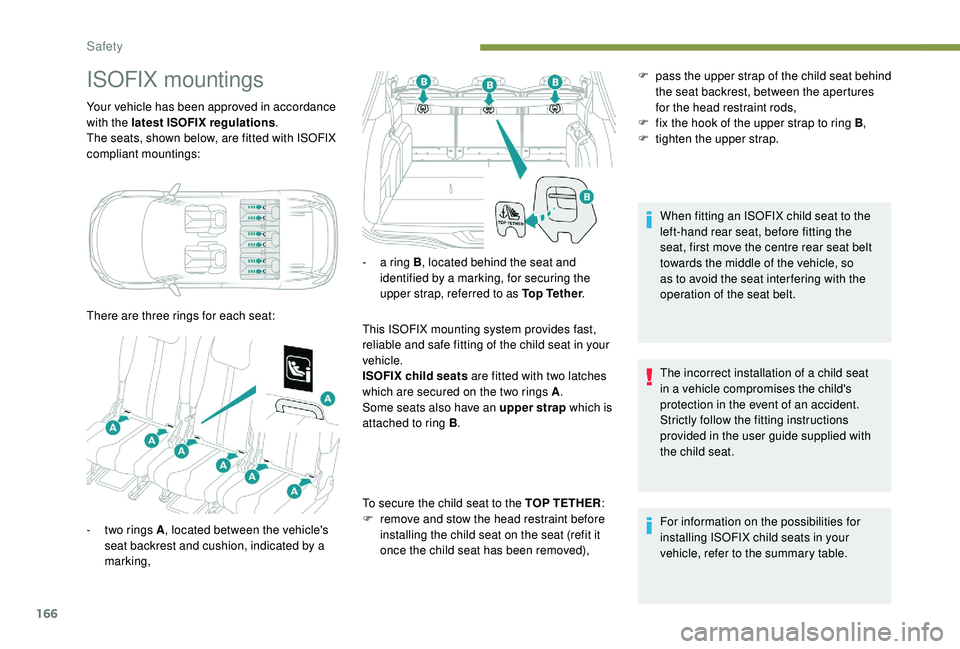
166
ISOFIX mountings
Your vehicle has been approved in accordance
with the latest ISOFIX regulations.
The seats, shown below, are fitted with ISOFIX
compliant mountings:
There are three rings for each seat: This ISOFIX mounting system provides fast,
reliable and safe fitting of the child seat in your
vehicle.
ISOFIX child seats are fitted with two latches
which are secured on the two rings A.
Some seats also have an upper strap which is
attached to ring B .
To secure the child seat to the TOP TETHER :
F
r
emove and stow the head restraint before
installing the child seat on the seat (refit it
once the child seat has been removed), When fitting an ISOFIX child seat to the
left-hand rear seat, before fitting the
seat, first move the centre rear seat belt
towards the middle of the vehicle, so
as to avoid the seat inter fering with the
operation of the seat belt.
The incorrect installation of a child seat
in a vehicle compromises the child's
protection in the event of an accident.
Strictly follow the fitting instructions
provided in the user guide supplied with
the child seat.
For information on the possibilities for
installing ISOFIX child seats in your
vehicle, refer to the summary table.
F
p
ass the upper strap of the child seat behind
the seat backrest, between the apertures
for the head restraint rods,
F
f
ix the hook of the upper strap to ring B,
F
t
ighten the upper strap.
-
t
wo rings A , located between the vehicle's
seat backrest and cushion, indicated by a
marking, -
a r
ing B, located behind the seat and
identified by a marking, for securing the
upper strap, referred to as Top Tether .
Safety
Page 169 of 404
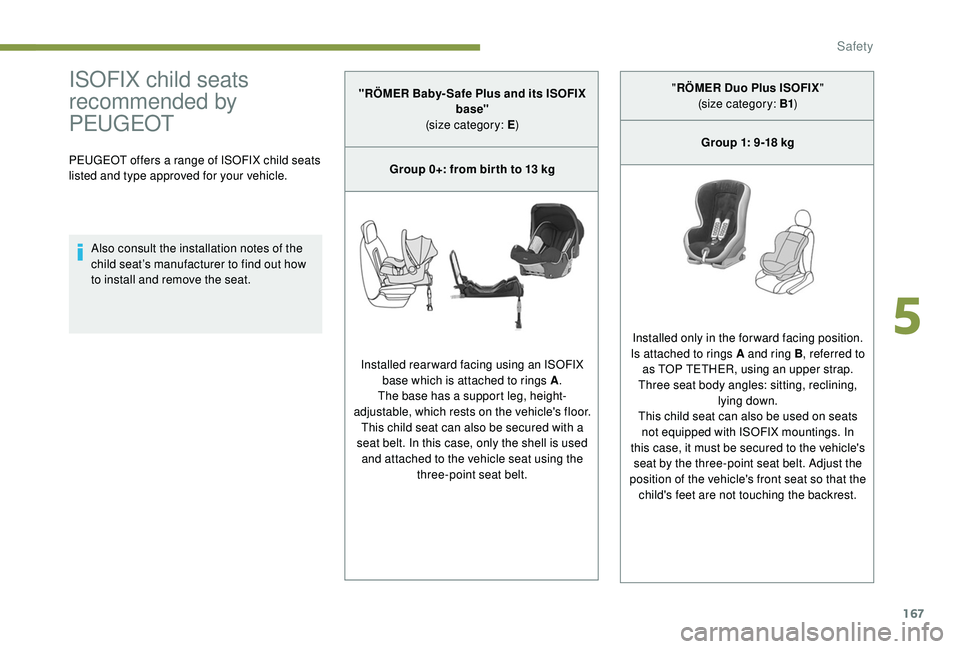
167
ISOFIX child seats
recommended by
PEUGEOT
PEUGEOT offers a range of ISOFIX child seats
listed and type approved for your vehicle.Also consult the installation notes of the
child seat’s manufacturer to find out how
to install and remove the seat. "RÖMER Baby- Safe Plus and its ISOFIX
base"
(size category: E )
Group 0+: from bir th to 13 kg
Installed rearward facing using an ISOFIX base which is attached to rings A .
The base has a support leg, height-
adjustable, which rests on the vehicle's floor. This child seat can also be secured with a
seat belt. In this case, only the shell is used and attached to the vehicle seat using the three-point seat belt. "
RÖMER Duo Plus ISOFIX "
(size category: B1 )
Group 1: 9-18 kg
Installed only in the forward facing position.
Is attached to rings A and ring B , referred to
as TOP TETHER, using an upper strap.
Three seat body angles: sitting, reclining, lying down.
This child seat can also be used on seats not equipped with ISOFIX mountings. In
this case, it must be secured to the vehicle's seat by the three-point seat belt. Adjust the
position of the vehicle's front seat so that the child's feet are not touching the backrest.
5
Safety
Page 174 of 404

172
The incorrect installation of a child seat in a
vehicle compromises the child's protection in
the event of an accident.
Check that there is no seat belt or seat belt
buckle under the child seat as this could
make it unstable.
Remember to fasten the seat belts or the
child seat harnesses keeping the slack
relative to the child's body to a minimum,
even for short journeys.
When installing a child seat using the seat
belt, ensure that the seat belt is tightened
correctly on the child seat and that it secures
the child seat firmly on the seat of your
vehicle. If your passenger seat is adjustable,
move it for wards if necessary.
At rear seating positions, always leave
sufficient space between the front seat and:
-
a "
rear ward facing" child seat,
-
t
he feet of a child seated in a "for ward
facing" child seat.
For this, move the seat for ward and, if
necessary, straighten its backrest too.
For optimal installation of the "forward facing"
child seat, verify that its backrest is as close
as possible to the backrest of the vehicle
seat, if possible in contact with it.
Advice
The head restraint must be removed before
installing a child seat with a backrest on a
passenger seat.
Ensure that the head restraint is stored or
attached securely to prevent it from being
thrown around the vehicle in the event of
sharp braking. Refit the head restraint once
the child seat has been removed. PEUGEOT recommends using a booster seat
with a backrest, equipped with a belt guide at
shoulder level.
As a safety precaution, do not leave:
-
a c
hild or children alone and unattended in
a vehicle,
-
a c
hild or an animal in a vehicle under the
sun, with the windows closed,
-
t
he keys within the reach of children inside
the vehicle.
To prevent accidental opening of the doors
and rear windows, use the child lock.
Take care not to open the rear windows by
more than one third.
To protect young children from the rays of the
sun, fit side blinds on the rear windows.
Children in front
The legislation on carrying children on the
front passenger seat is specific to each
country. Refer to the legislation in force in
your country.
Deactivate the passenger's front airbag when
a rear ward facing child seat is installed on the
front passenger seat.
Otherwise, the child risks being seriously
injured or killed if the airbag is deployed.
Installing a booster seat
The chest part of the seat belt must be
positioned on the child's shoulder without
touching the neck.
Ensure that the lap part of the seat belt
passes correctly over the child's thighs.
Safety
Page 195 of 404
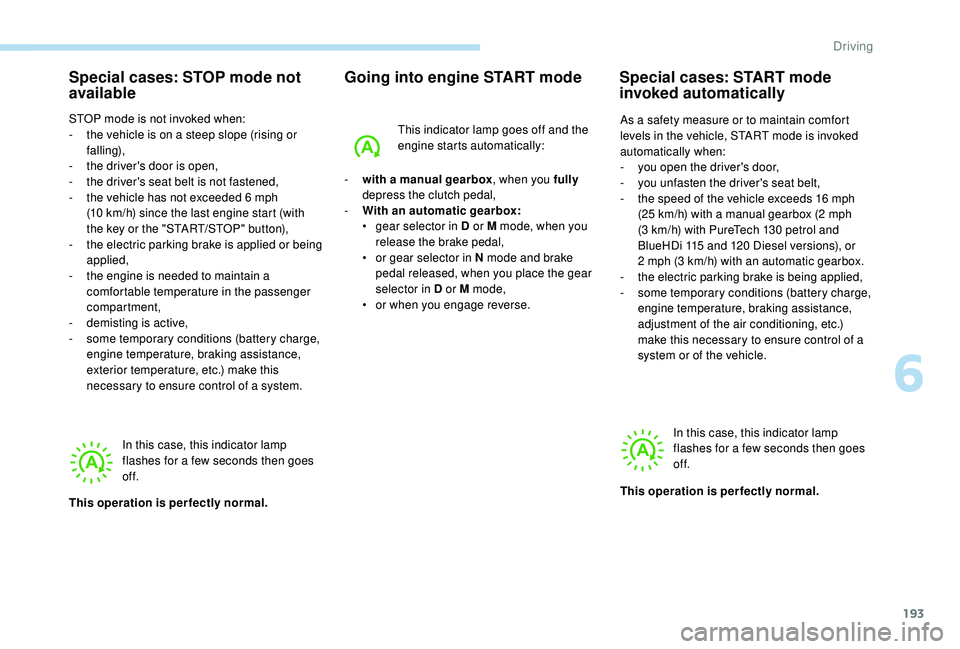
193
Special cases: STOP mode not
available
STOP mode is not invoked when:
- t he vehicle is on a steep slope (rising or
falling),
-
t
he driver's door is open,
-
t
he driver's seat belt is not fastened,
-
t
he vehicle has not exceeded 6 mph
(10
km/h) since the last engine start (with
the key or the "START/STOP" button),
-
t
he electric parking brake is applied or being
applied,
-
t
he engine is needed to maintain a
comfortable temperature in the passenger
compartment,
-
d
emisting is active,
-
s
ome temporary conditions (battery charge,
engine temperature, braking assistance,
exterior temperature, etc.) make this
necessary to ensure control of a system.
Going into engine START mode
In this case, this indicator lamp
flashes for a few seconds then goes
of f.
This operation is perfectly normal. -
w
ith a manual gearbox
, when you fully
depress the clutch pedal,
-
W
ith an automatic gearbox:
•
g
ear selector in D or M mode, when you
release the brake pedal,
•
o
r gear selector in N mode and brake
pedal released, when you place the gear
selector in D or M mode,
•
o
r when you engage reverse.This indicator lamp goes off and the
engine starts automatically:
Special cases: START mode
invoked automatically
As a safety measure or to maintain comfort
levels in the vehicle, START mode is invoked
automatically when:
-
y
ou open the driver's door,
-
y
ou unfasten the driver's seat belt,
-
t
he speed of the vehicle exceeds 16 mph
(25
km/h) with a manual gearbox (2 mph
(3
km/h) with PureTech 130 petrol and
BlueHDi 115
and 120 Diesel versions), or
2
mph (3 km/h) with an automatic gearbox.
-
t
he electric parking brake is being applied,
-
s
ome temporary conditions (battery charge,
engine temperature, braking assistance,
adjustment of the air conditioning, etc.)
make this necessary to ensure control of a
system or of the vehicle.
In this case, this indicator lamp
flashes for a few seconds then goes
of f.
This operation is perfectly normal.
6
Driving
Page 220 of 404
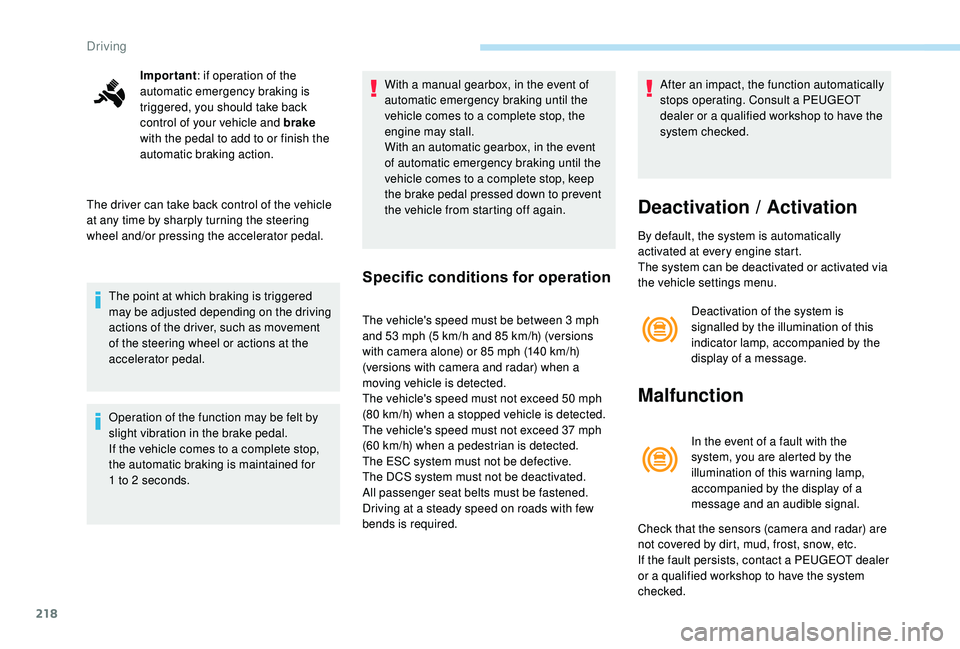
218
Important: if operation of the
automatic emergency braking is
triggered, you should take back
control of your vehicle and brake
with the pedal to add to or finish the
automatic braking action.
The driver can take back control of the vehicle
at any time by sharply turning the steering
wheel and/or pressing the accelerator pedal.
The point at which braking is triggered
may be adjusted depending on the driving
actions of the driver, such as movement
of the steering wheel or actions at the
accelerator pedal.
Operation of the function may be felt by
slight vibration in the brake pedal.
If the vehicle comes to a complete stop,
the automatic braking is maintained for
1
to 2
seconds. With a manual gearbox, in the event of
automatic emergency braking until the
vehicle comes to a complete stop, the
engine may stall.
With an automatic gearbox, in the event
of automatic emergency braking until the
vehicle comes to a complete stop, keep
the brake pedal pressed down to prevent
the vehicle from starting off again.
Specific conditions for operation
The vehicle's speed must be between 3 mph
a nd 53 mph (5 km/h and 85 km/h) (versions
with camera alone) or 85
mph (140 km/h)
(versions with camera and radar) when a
moving vehicle is detected.
The vehicle's speed must not exceed 50
mph
(80 km/h) when a stopped vehicle is detected.
The vehicle's speed must not exceed 37
mph
(60
km/h) when a pedestrian is detected.
The ESC system must not be defective.
The DCS system must not be deactivated.
All passenger seat belts must be fastened.
Driving at a steady speed on roads with few
bends is required. After an impact, the function automatically
stops operating. Consult a PEUGEOT
dealer or a qualified workshop to have the
system checked.
Deactivation / Activation
By default, the system is automatically
activated at every engine start.
The system can be deactivated or activated via
the vehicle settings menu.
Deactivation of the system is
signalled by the illumination of this
indicator lamp, accompanied by the
display of a message.
Malfunction
In the event of a fault with the
system, you are alerted by the
illumination of this warning lamp,
accompanied by the display of a
message and an audible signal.
Check that the sensors (camera and radar) are
not covered by dirt, mud, frost, snow, etc.
If the fault persists, contact a PEUGEOT dealer
or a qualified workshop to have the system
checked.
Driving
Page 222 of 404

220
Driving time warning
The system triggers an alert once it
detects that the driver has not taken
a break after two hours of driving at
a speed above 40 mph (65 km/h).
The system resets itself if one of the following
conditions is met:
-
e
ngine running, the vehicle has been
stationary for more than 15
minutes,
-
t
he ignition has been switched off for a few
minutes,
-
t
he driver's seat belt is unfastened and their
door is open. As soon as the speed of the vehicle drops
below 40
mph (65 km/h), the system goes
into standby.
The driving time is counted again once the
speed is above 40
mph (65 km/h).
Driver inattention alert
Depending on version, the "Driving time
warning" may be combined with the "Driver
inattention alert".
After three first level alerts, the system triggers
a new alert with the message "Take a break!",
accompanied by a more pronounced audible
signal.
In certain driving conditions (poor road
sur face or strong winds), the system may
give alerts independent of the driver's
level of vigilance.
This alert is issued via the display of a
message encouraging you to take a break,
accompanied by an audible signal.
If the driver does not follow this advice, the
alert is repeated hourly until the vehicle is
stopped.
Using a camera placed at the top
of the windscreen, the system
assesses the driver's level of
vigilance by identifying variations
in trajectory compared to the lane
markings.
This system is particularly suited to fast roads
(speed higher than 40
mph (65 km/h)). When the system interprets the behaviour of
the vehicle as indicating a certain fatigue or
inattention threshold on the part of the driver, it
triggers the first level of alert.
The driver is then alerted by the message
"
Ta k e c a r e ! ", accompanied by an audible
signal.
Driving
Page 288 of 404
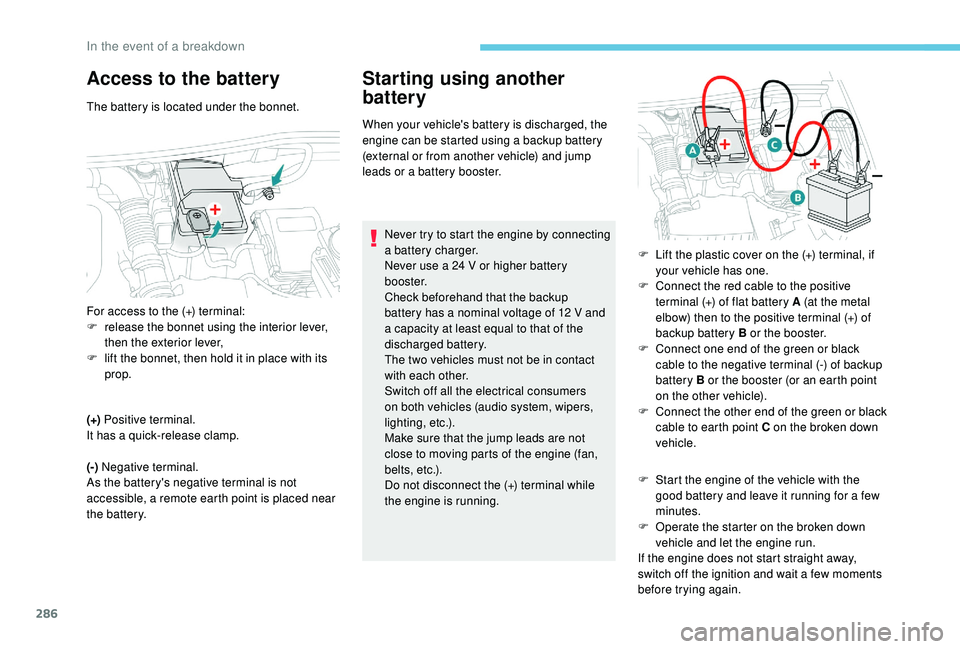
286
Access to the battery
The battery is located under the bonnet.
(+) Positive terminal.
It has a quick-release clamp.
(-) Negative terminal.
As the battery's negative terminal is not
accessible, a remote earth point is placed near
the battery.
Starting using another
battery
When your vehicle's battery is discharged, the
engine can be started using a backup battery
(external or from another vehicle) and jump
leads or a battery booster.
Never try to start the engine by connecting
a battery charger.
Never use a 24
V or higher battery
b o o s t e r.
Check beforehand that the backup
battery has a nominal voltage of 12 V and
a capacity at least equal to that of the
discharged battery.
The two vehicles must not be in contact
with each other.
Switch off all the electrical consumers
on both vehicles (audio system, wipers,
lighting, etc.).
Make sure that the jump leads are not
close to moving parts of the engine (fan,
belts, etc.).
Do not disconnect the (+) terminal while
the engine is running. F
S
tart the engine of the vehicle with the
good battery and leave it running for a few
minutes.
F
O
perate the starter on the broken down
vehicle and let the engine run.
If the engine does not start straight away,
switch off the ignition and wait a few moments
before trying again.
For access to the (+) terminal:
F
r
elease the bonnet using the interior lever,
then the exterior lever,
F
l
ift the bonnet, then hold it in place with its
prop. F
L
ift the plastic cover on the (+) terminal, if
your vehicle has one.
F
C
onnect the red cable to the positive
terminal (+) of flat battery A (at the metal
elbow) then to the positive terminal (+) of
backup battery B or the booster.
F
C
onnect one end of the green or black
cable to the negative terminal (-) of backup
battery B or the booster (or an earth point
on the other vehicle).
F
C
onnect the other end of the green or black
cable to earth point C on the broken down
vehicle.
In the event of a breakdown
Page 395 of 404

297
Accessories .......................................... 13 8, 18 0
Active Safety Brake..................... 1 6 -17, 215 -218
AdBlue
® additive ............................. 3 2, 262-265
Adjusting headlamps .................................... 128
Adjusting head restraints
................................ 79
Adjusting seats
......................... 7 6 - 7 7, 79, 85 - 87
Adjusting the air distribution
...................9 9 -10 2
Adjusting the air flow
............................... 9
9 -10 2
Adjusting the date
......................... 38-39, 36, 20
Adjusting the height and reach of the steering wheel
.................................... 83
Adjusting the lumbar support
............... 7
6 - 7 7, 79
Adjusting the seat belt height
....................... 14
9
Adjusting the temperature
......................9 9 -10 2
Adjusting the time
......................... 38-39, 36, 20
Advanced Grip Control
.......................... 145 -14 6
Advice on driving
................................... 175 -176
Airbags
...............................
.............18, 15 3, 15 8
Airbags, curtain
...................................... 15 5 -15 6
Airbags, front ................................. 15 3 -15 4, 15 6
Airbags, lateral
...................................... 15 4, 15 6
Air conditioning
......................................... 96, 98
Air conditioning, automatic
.............................95
Air conditioning, digital
........................... 99, 103
Air conditioning, dual-zone automatic
....99, 103
Air conditioning, manual
................... 9
5-96, 103
Air conditioning, mono-zone
.............97- 9 8 , 103
Air intake
................................................. 9 9 -10 2
Air vents
.......................................................... 94
Alarm
............................................................... 61
Amplifier, audio
...............................
..............112
Anti-lock braking system (ABS)
..............15, 142
Anti-slip regulation (ASR)
............................. 142Anti-theft
.......................................................
17 7
Armrest, front ................................................
114
Assistance call
...............................
........
13 9 -141
Assistance, emergency braking
...........
142, 217
Audio streaming (Bluetooth)
.....................
2 7, 11
Auxiliary
..........................................
2 6 - 2 7, 1 0 -11 Cable, audio
..............................................
26, 10
Cable, jack
................................................
26, 10
Capacity, fuel tank
........................................
245
CarPlay connection ................................... 18, 13
Cartridge, fragrance
.............................. 11
4 -115
CD
........................................................
2 6 - 2 7, 11
CD, MP3
...............................................
2 6 - 2 7, 11
Central locking .......................................... 5 3,
60
Changing a bulb ..................... 2
78-279, 281-283
Changing a fuse
.................................... 28
4-285
Changing a wheel
.................. 2
67-269, 273-274
Changing a wiper blade
........................ 13
6, 284
Changing the remote control battery
..............58
Charger, induction
..................................112 -113
Charger, wireless
................................... 11
2 -113
Checking the engine oil level
..........................30
Checking the levels
...............................258-260
Checking tyre pressures (using the kit)
..............................269-270, 272
Checks
..........................................2 5 7, 260-262
Checks, routine
.....................................260-262
Child lock
................................................173 -174
Children
.................................16 4, 166 -168, 170
Children (safety)
.....................................173 -174
Child seats
.............15
2, 157-15 8, 162-16 4, 172
Child seats, conventional
......................163 -16 4
Child seats, i-Size
.........................................170
Child seats, ISOFIX
.......................166 -168, 170
Cigarette lighter
............................................111
Closing the boot
............................51
, 54-55, 65
Closing the doors
..........................51, 53-55, 64
Configurations, seats
......................................92
Configuration, vehicle
......................... 3
8 - 42, 45
Connection, Bluetooth
........ 21
-22, 28-30, 15 -17
Connection, MirrorLink
........................19, 12-14
Connection, Wi-Fi network
.............................22
Control, emergency door
................................ 57
C
ontrol, heated seats
................................81- 82
Controls, steering mounted
...................185 -189
A
B
C
Backrest, folding ............................................. 78
B attery ..................... 13, 252, 260, 285-286, 288
Battery charge (warning lamp)
.......................13
Battery, charging
.................................... 287-288
Battery, remote control
.............................56, 58
Blanking screen (snow shield)
......................253
Blind
..............................
..................................70
Blind spot monitoring system
..........23, 227-229
Blind spot monitoring system, active
......23, 229
Blind spot sensors
..........................23, 227-229
Blinds, side
.................................................... 11 9
BlueHDi
.................................... 32, 34, 262, 266
Bluetooth (hands-free)
................... 2
8-29, 15 -16
Bluetooth (telephone)
..................... 2
8-30, 15 -17
Bonnet
........................................................... 256
Boot
............................................. 64-65, 6 7, 123
Boot (fittings)
................................................. 120
Brake discs
............................................ 261-262
Brake lamps
...............................
...................281
Brakes
.............................................. 15, 261-262
Braking assistance system
...........................142
Braking, automatic emergency
...1 6 -17, 215 -218
Braking, dynamic emergency
................181-18 4
Brightness
....................................................... 19
Bulbs
............................................................. 278
Bulbs (changing)
....................278-279, 281-283
180° rear vision
....................................
233, 235
.
Alphabetical index